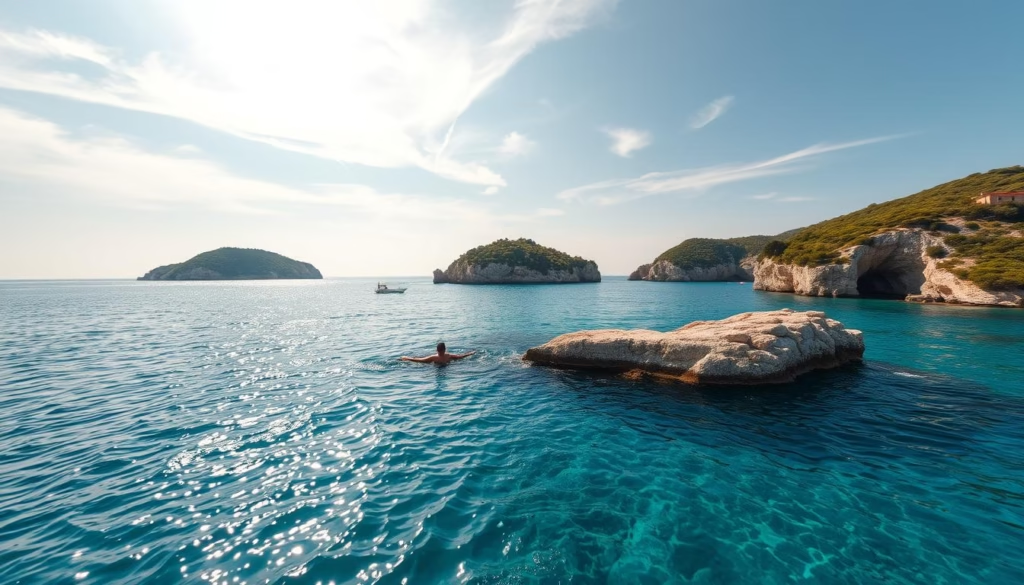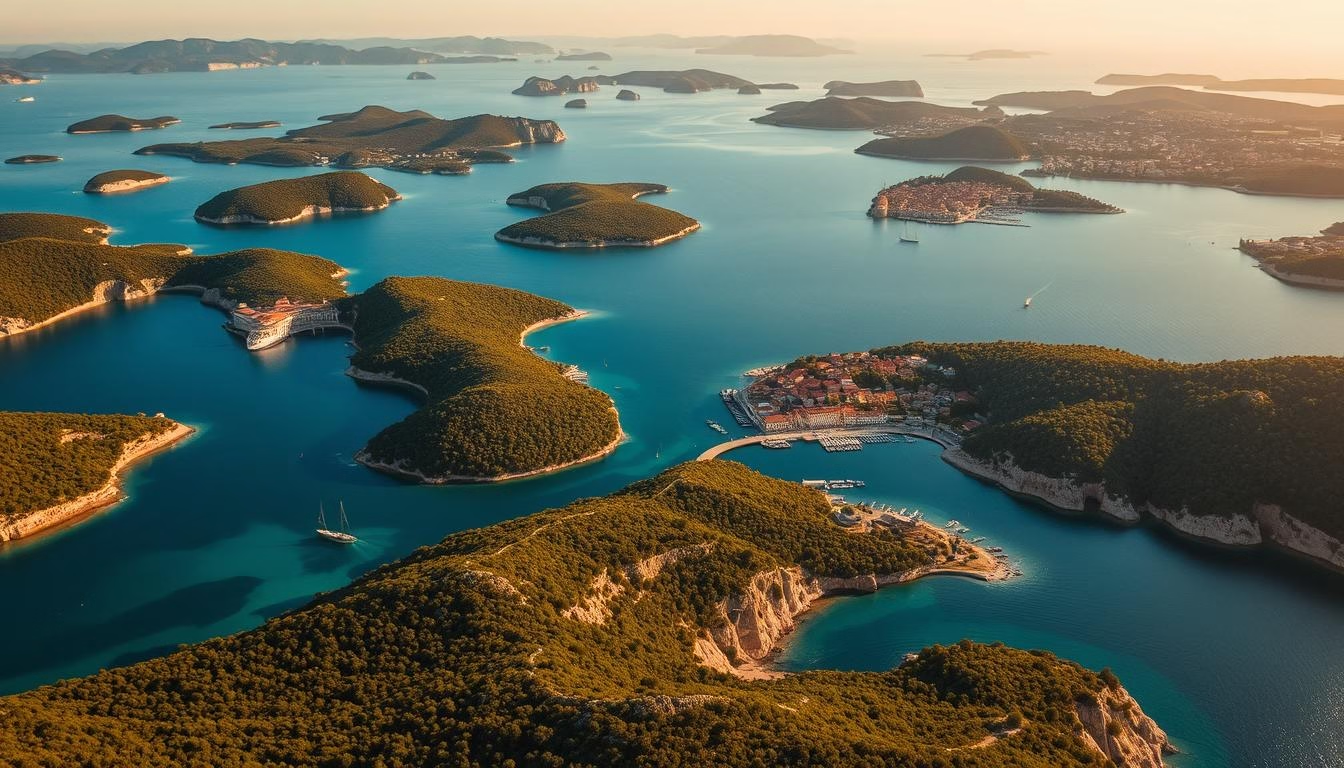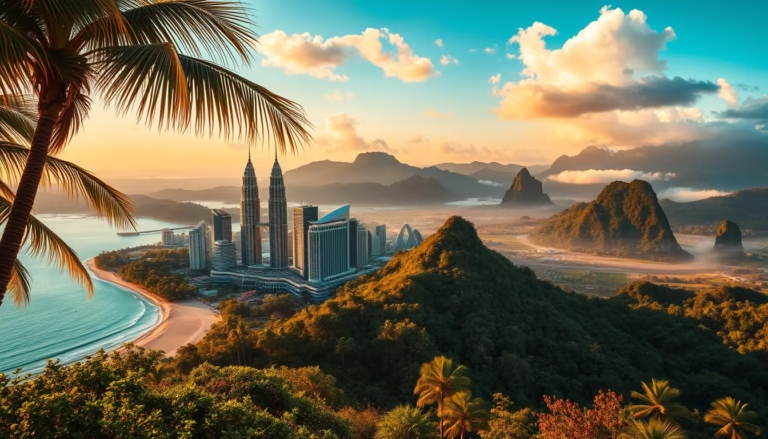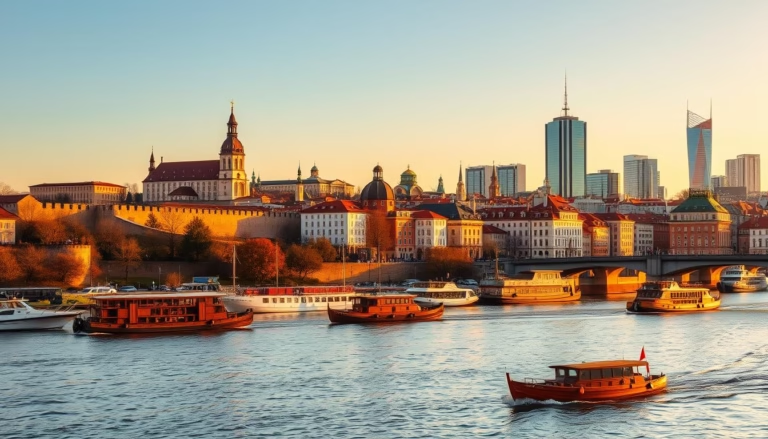Explore the Best Croatian Islands: Top Picks & Hidden Gems
Picture a coastline dotted with over 1,000 landmasses, each offering its own blend of adventure and relaxation. Croatia’s Adriatic shores deliver exactly that—a mosaic of vibrant towns, quiet beaches, and waters so clear you’ll spot fish darting 20 feet below. Summer temperatures here hover between 72°F and 86°F, making it ideal for swimming or sailing through sheltered coves.
From lively hubs buzzing with nightlife to secluded spots where nature takes center stage, this country has something for every traveler. History buffs can wander through ancient stone villages, while sun-seekers unwind on pebbled beaches kissed by turquoise waves. The Adriatic’s calm currents and mild salinity even let you float effortlessly—perfect for lazy afternoons on the water.
This guide unlocks both popular hotspots and lesser-known treasures across the archipelago. You’ll discover how to craft an itinerary that balances iconic destinations with hidden bays where crowds fade away. Ready to dive in?
Key Takeaways
- Discover over 1,000 landmasses along Croatia’s stunning coastline
- Enjoy crystal-clear waters with visibility up to 20 feet deep
- Choose between vibrant social scenes or peaceful natural retreats
- Explore historic sites dating back centuries
- Experience ideal summer temperatures for water activities
- Get insider tips for balancing popular spots with hidden gems
Welcome to Croatia’s Island Wonderland
Imagine dipping your toes into waters so transparent, every pebble on the seabed winks back at the sun. The Adriatic Sea cradles over 1,000 landmasses like scattered jewels, where summer temperatures hover between 72°F and 86°F. These conditions turn every cove into a natural swimming pool—salty enough to float effortlessly, yet gentle on the skin.

You’ll find endless ways to enjoy the water here. Sailors love the calm currents that make island-hopping stress-free, while snorkelers marvel at underwater worlds visible from the surface. Prefer dry land? Wander through harbors buzzing with yacht parties or stone villages where fishermen mend nets as they’ve done for centuries.
What makes these destinations stand out? Diversity. One spot might offer cliffside vineyards, while another hides olive groves framing secluded beaches. The archipelago’s magic lies in its balance—vibrant social scenes coexist with untouched nature, all within a short boat ride.
- Saltwater so buoyant you’ll feel weightless
- Marine life visible through 20-foot-deep crystal waves
- Microclimates creating unique ecosystems on each landmass
Whether you’re paddleboarding at dawn or sipping local wine at sunset, Croatia’s coastal treasures deliver moments that linger long after your sandals dry.
Why Visit Croatia? Culture, Nature, and Heritage Explored
Step into a land where Roman ruins meet modern marinas, and medieval walls frame bustling cafes. This country thrives as a cultural crossroads, welcoming nearly 20 million travelers annually to its sunlit shores. Its EU membership and Schengen Area access mean hassle-free travel for Americans, with the euro simplifying transactions.
Centuries of history whisper through cobblestone streets. Diocletian’s Palace in Split—a 4th-century Roman marvel—doubles as a living neighborhood. Venetian bell towers rise above Dubrovnik’s orange rooftops, part of a UNESCO World Heritage site protected since 1979. Eight other Croatian landmarks share this prestigious status, from Plitvice Lakes’ waterfalls to Trogir’s stone-carved old town.
| Cultural Influence | Signature Feature | Location Example |
|---|---|---|
| Roman Empire | Amphitheaters & Palaces | Pula, Split |
| Venetian Republic | Gothic Architecture | Dubrovnik, Zadar |
| Ottoman Era | Fortress Networks | Knin, Sinj |
Croatia’s heritage isn’t just ancient—it’s alive. Families still press olive oil using methods from their great-grandparents’ era. Fishermen sing traditional klapa harmonies while mending nets. As a NATO member and UN participant, the country offers stability alongside adventures, whether you’re truffle hunting in Istria or sailing the Dalmatian Coast.
Top Mediterranean Adventures on the Dalmatian Coast
Ever wondered where to find turquoise waters meeting sun-baked cliffs teeming with excitement? The Dalmatian Coast delivers this magic, blending heart-pumping activities with serene natural beauty. Split’s historic harbor serves as your gateway, with ferries whisking travelers to nearby gems like Brač in under an hour.
Adventure thrives in these protected channels. Sailors chase steady winds between islands, while snorkelers explore underwater caves glowing with marine life. Prefer staying dry? Scale limestone cliffs near Bol for panoramic views of the Dalmatian Coast – your reward after a challenging climb.
Swap crowded spots like the Blue Cave for hidden coves accessible only by kayak. Paddle through sea tunnels to discover beaches where your footprints might be the first of the day. The Adriatic’s calm water here feels like swimming in liquid glass, perfect for beginners and experts alike.
- Sunset sailing tours with local captains
- Cliff-jumping spots known only to residents
- Snorkeling trails marked by ancient shipwrecks
This stretch of the Mediterranean isn’t just about thrills – it’s where culture meets coastline. After a day of exploration, join fishermen grilling fresh catch on pebbled shores, sharing stories as old as the stone villages behind them.
Best Croatian Islands for Every Traveler
Navigating Croatia’s coastal gems can feel like solving a delightful puzzle. With over 1,000 landmasses stretching from Istria to Dubrovnik, each offers distinct flavors – think Venetian-era towns, pine-fringed beaches, and watersports havens. Our curated list helps you cut through the noise.
Love moonlit beach parties? Hvar’s electric nightlife delivers. Prefer solitude? Mljet’s saltwater lakes and oak forests create a nature lover’s sanctuary. History enthusiasts rave about Korčula’s medieval walls, where Marco Polo’s childhood home still stands.
| Traveler Type | Recommended Landmass | Highlights |
|---|---|---|
| Social Butterflies | Hvar | Beach clubs, yacht events |
| Outdoor Explorers | Brač | Vidova Gora summit, windsurfing |
| Culture Seekers | Korčula | Gothic-Renaissance architecture |
| Budget Wanderers | Vis | Authentic villages, WWII tunnels |
Families flock to Rab’s shallow bays, while thrill-seekers tackle Brač’s rock-climbing routes. For a quieter vibe, Vis – once closed to tourists – charms with untouched fishing ports. This visual guide showcases each destination’s personality through stunning photography.
No two landmasses here play the same tune. Whether you’re sipping Pelješac wine at sunset or kayaking past ancient shipwrecks, Croatia’s coast writes adventures that fit like a favorite pair of sandals.
Island Spotlight: Brač – Charm and Versatile Activities
Just 50 minutes from Split’s bustling harbor, Brač emerges as a sunlit playground where marble cliffs meet pine-scented trails. This landmass blends practicality with wonder—easy to reach yet endlessly surprising.
Getting There and Ferry Options
Two main routes connect Split to Brač. Jadrolinija’s car ferry docks in Supetar, while faster catamarans zip to Bol’s golden beaches:
| Route | Duration | 2025 Peak Season Price |
|---|---|---|
| Split-Supetar (ferry) | 50 minutes | €6.50 per person |
| Split-Bol (catamaran) | 1 hour | €9.70 per person |
Traveling with wheels? Add €26.10 for vehicle transport on the Supetar route. Morning departures run every 90 minutes during summer.
Top Attractions and Local Experiences
Brač’s white stone built empires. Wander Supetar’s quarries where workers once cut marble for Diocletian’s Palace and the White House. Later, conquer Vidova Gora—Dalmatia’s highest peak at 2,552 feet.
Adventure seekers rave about these activities:
- Windsurfing near Zlatni Rat’s shifting spit
- Rock climbing on lunar-like coastal formations
- Tasting olive oil from 500-year-old groves
Don’t miss Škrip village’s stone houses, where museum displays reveal ancient olive presses. As locals say: “Brač doesn’t compete—it simply exists, perfect and unchanged.”
Island Spotlight: Hvar – Party, History, and Scenic Beauty
Where can you dance under Venetian-era chandeliers by night and walk through ancient olive groves by day? Hvar reveals its dual personality through sunlit stone streets and moonlit beach clubs. This island wears its 2,400-year history like a well-tailored suit—polished yet full of surprises.
Hvar Town’s Historic and Modern Vibes
St. Stephen’s Square anchors the town with Renaissance palaces framing its limestone expanse. The 16th-century cathedral’s bell tower offers views stretching to the Pakleni archipelago. Just 15 minutes away, the Stari Grad Plain—a UNESCO World Heritage site—showcases Greek land divisions still used by local farmers.
Nightlife and Leisure on the Island
When sunset paints the harbor gold, Hvar shifts gears. Exclusive clubs pulse with DJ beats, while cocktail bars serve lavender-infused drinks. For quieter evenings, kayak to nearby islets or join a wine tasting at vineyards older than Shakespeare’s plays.
| Daytime Activities | Nighttime Experiences | Hidden Gems |
|---|---|---|
| Guided walking tours | Beach club parties | Ancient olive groves |
| UNESCO site visits | Sunset yacht cruises | Carob honey tastings |
| Lavender field photo ops | Rooftop cocktail bars | Abandoned fishing villages |
Locals often say: “Hvar doesn’t ask what you want—it shows you what you’ve been missing.” Whether exploring 13th-century monasteries or dancing till dawn, this island proves architecture and adrenaline make perfect partners.
Island Spotlight: Korčula – Medieval Treasures and Wine Culture
Step through ancient stone gates into a world where spiral staircases twist toward terracotta rooftops. Korčula town enchants with its 13th-century Venetian architecture, its streets laid out in a fishbone pattern to tame coastal winds. Don’t miss the alleged birthplace of Marco Polo – locals will eagerly point you to the explorer’s family home.
The island’s crown jewel? Saint Mark’s Cathedral. This 14th-century marvel blends Gothic and Renaissance styles, its bell tower offering panoramic Adriatic views. Just 10 minutes east lies Lumbarda village, where sandy vineyards produce Grk – a crisp white wine made from grapes found nowhere else.
Korčula’s culture flows as richly as its Pošip wines. Sample this golden specialty at family-run konobas, paired with octopus salad or homemade bread. As sunset gilds the stone walls, you’ll understand why this island has inspired artists and sailors for centuries.






